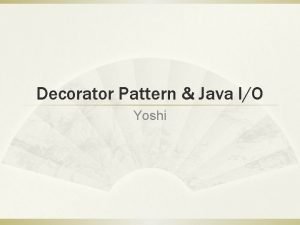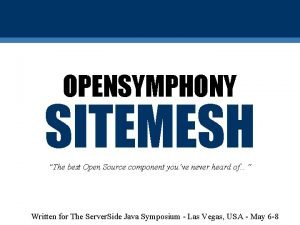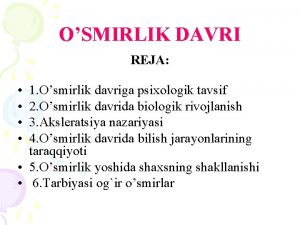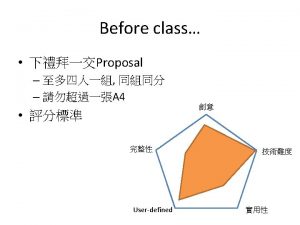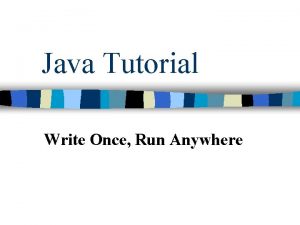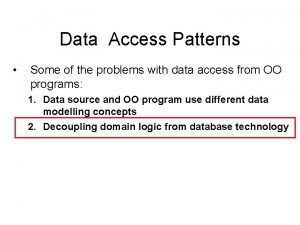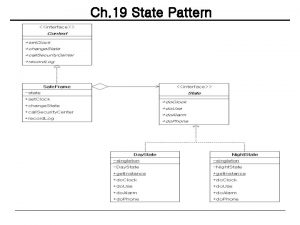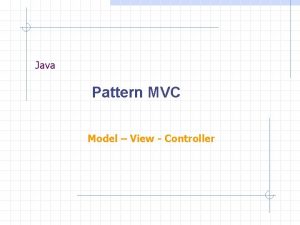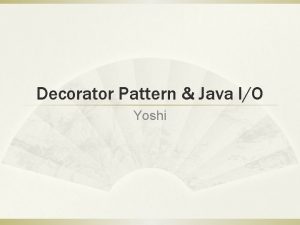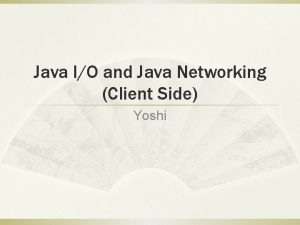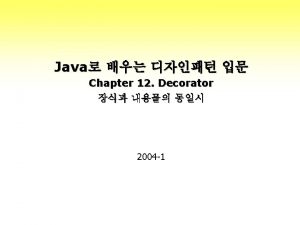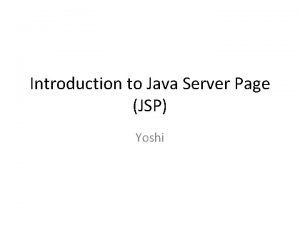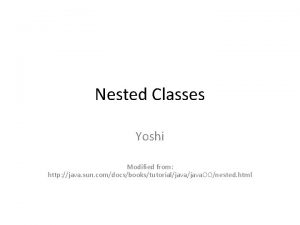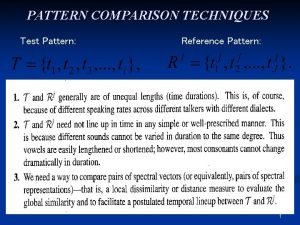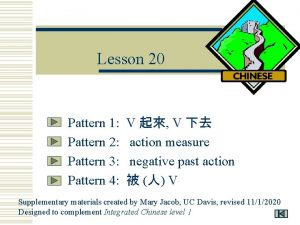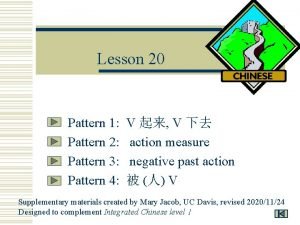Decorator Pattern Java IO Yoshi Why decorator Once



























- Slides: 27

Decorator Pattern & Java I/O Yoshi

Why decorator? ß Once you know the techniques of decorating, you’ll be able to give your (or someone else’s) objects new responsibilities without making any code changes to the underlying classes.


Abstract class 飲料 description get. Description () get. Price() Abstract method 奶茶 咖啡 get. Price()


Abstract class 飲料 description get. Description () get. Price() Abstract method 奶茶 get. Price() 珍珠奶茶 Class大爆炸 咖啡 摩卡咖啡 拿鐵咖啡 get. Price() 布丁奶茶 椰果奶茶 奶茶三兄弟? 加濃摩卡咖啡? get. Price()

飲料 換個想法? int get. Price() { int price=0; if(has大珍珠()) { price+=5; } if(has小珍珠()) { price+=5; } if(has椰果()) { price+=7; } if(has布丁()) { price+=10; } … return price; } description 大珍珠 小珍珠 椰果 布丁 巧克力 牛奶 … get. Description () get. Price() has大珍珠() set大珍珠() has小珍珠() set小珍珠() has椰果() set椰果() has布丁() set布丁() has巧克力() set巧克力() has牛奶()






PS: You can download the code at course web

What we have now? ß ß ß Decorators have the same supertype as the object they decorate You can use more than one decorators as a chain to decorator a single object Decorators are transparent, so we can replace original Component with a decorator one anywhere The decorator adds its own behavior either before and/or after delegating to the object it decorates to do the job Objects can be decorated at runtime!


Participants ß Component Þ ß Concrete component Þ ß Define an object to which additional responsibility can be attached Decorator Þ ß Define an interface for objects that can have responsibility added to them dynamically Maintain a reference to a Component object and define an interface that conform to Component’s interface Concrete decorator Þ Add responsibilities to the component

Question ß ß Why not just let Concrete. Decorator extend Component? Try the code!

Because… ß This example is still too simple Þ Let’s take a look at the design of java. io


Can you map it back to decorator pattern?

See ß java. io. Input. Stream Þ ß http: //java. sun. com/j 2 se/1. 5. 0/docs/api/java/io/ Input. Stream. html java. io. Filter. Input. Stream Þ http: //java. sun. com/j 2 se/1. 5. 0/docs/api/java/io/ Filter. Input. Stream. html

java. io. Input. Stream Why only one abstract? Remember Template Method Pattern?

java. io. Filter. Input. Stream ß The class Filter. Input. Stream itself simply overrides all methods of Input. Stream with versions that pass all requests to the contained input stream. Þ ß In short, delegation! Subclasses of Filter. Input. Stream may further override some of these methods and may also provide additional methods and fields. Þ Þ In short, help you override all the methods defined in java. io. Input. Stream You can provide additional functionalities in decorators

RTFSC 26 package java. io; 45 public class Filter. Input. Stream extends Input. Stream { 50 protected volatile Input. Stream in; 61 protected Filter. Input. Stream(Input. Stream in) { 62 this. in = in; 63 } 82 public int read() throws IOException { 83 return in. read(); 84 } 106 public int read(byte b[]) throws IOException { 107 return read(b, 0, b. length); 108 } 132 public int read(byte b[], int off, int len) throws IOException { 133 return in. read(b, off, len); 134 } 141 public long skip(long n) throws IOException { 142 return in. skip(n); 143 }

158 159 160 171 172 173 174 191 192 193 194 216 217 218 219 233 234 235 236 } public int available() throws IOException { return in. available(); } public void close() throws IOException { in. close(); } public synchronized void mark(int readlimit) { in. mark(readlimit); } public synchronized void reset() throws IOException { in. reset(); } public boolean mark. Supported() { return in. mark. Supported(); }

After RTFSC ß Without this, the all delegating works need to be done by yourself!

Finally ß Can you give an example to use this pattern?
 Java io decorator pattern
Java io decorator pattern Sitemesh decorator
Sitemesh decorator Nutritiv nazariya
Nutritiv nazariya Mvc java swing
Mvc java swing Yoshi
Yoshi Yoshi ohno
Yoshi ohno Hey bye bye
Hey bye bye Dont ask why why why
Dont ask why why why Java write once run anywhere
Java write once run anywhere Strategies in action
Strategies in action Fingerprint minutiae types
Fingerprint minutiae types Pattern and pattern classes in image processing
Pattern and pattern classes in image processing Max pattern and closed pattern
Max pattern and closed pattern Nfrequent
Nfrequent Data access object pattern
Data access object pattern Strategy pattern definition
Strategy pattern definition Plugin design pattern
Plugin design pattern паттерн mvc java
паттерн mvc java Factory design pattern java
Factory design pattern java State design pattern java
State design pattern java Java observer design pattern
Java observer design pattern Reactor pattern java
Reactor pattern java Model view controller
Model view controller Java command pattern
Java command pattern Memento design pattern java
Memento design pattern java Memento pattern java
Memento pattern java Import java.util.*
Import java.util.* Java import java.util.*
Java import java.util.*
